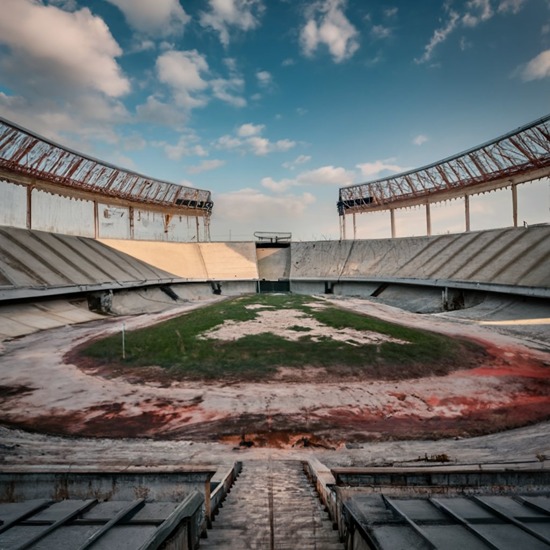Abandoned Olympic Venues: Emptier, Sadder, Scarier
The Olympic Games are held once every four years – except in cases of world wars or global epidemics. Many sports fans spend long hours a day watching more or less legitimate competitions. Sports fans come from all over the world to watch the games from the shortest possible distance. The exciting events of the Olympics, such as the finals of athletics or swimming, further increase the ratings. Many millions watch in front of the television screens, the stadiums are full (more or less), and we are excited by every world record or sporting sensation. Then, the Olympics are over, and we enter the pages of history.
The problem is that a horror movie might start after the game ends. The first one regards the athletes who failed, which are multiple (after all, there are only three spots on the podium). The host country often licks its wounds with financial expenses, not paying for themselves. And the stadiums, built at huge sums, become unusable. Some of them become completely abandoned, and in time, also horrific.
Why Are There Abandoned Olympic Venues?
There are many magical things in the Olympics. It combines sports at the highest level (well, at least in most branches), is a meeting between cultures, and includes many human stories.
Technically, however, this is one of the most complex logistical challenges. For the Olympics to start, we need infrastructure, stadiums, Olympic villages, accommodation solutions for the visitors – and the list goes on. The financial expenses are enormous and easily reach tens of billions of dollars, as those in London or Beijing can surely tell. Part of the story is that the countries see infrastructure building as an opportunity to show off and brag about bombastic buildings that cost a fortune. But what happens after the closing ceremony of the Olympics?

Astronomical Financial Costs
The main problem, as far as we understand, is that these costs fall mainly on the host countries, with a significant percentage of the direct profits going to an organization like the Olympic Committee. Countries may enter an economic crisis, no less “thanks” to the games (the 2004 Athens Olympics is a clear example). The financial damage may make it impossible to continue operating the stadiums even after the Olympics. Soon after, the creation of abandoned Olympic venues seemed logical.
It would be profitable to a certain extent to hold the Olympics. It may bring indirect and long-term economic profit to the city itself, as in the case of the 1992 Barcelona Olympics, which, according to some experts, was one of the main factors in making Barcelona such a central destination on the world tourism map. They built the promenade connected to the Olympic stadium to prepare for the Olympics. On the promenade, countless cafes and restaurants attract tourists and bring profits to the city’s coffers.

Who Needs These Stadiums Anyway?
Regardless of the question of costs, there is no need to continue using the Olympic facilities. The large fields can prepare tens of thousands of spectators, and in most locations, there is no demand for stadiums of this type after the Olympics – Creating abandoned Olympic venues easily, at least most of the time.
Let’s take the Pyeongchang Olympic Stadium in South Korea as a classic example of abandoned Olympic sites. The Koreans used it for the 2018 Winter Olympics and the Paralympic Games shortly after. Building the 35,000-seat stadium (the city has only about 40,000 residents!) costs about 109 million dollars. In practice, they only used it for the Olympics’ opening and closing ceremonies before destroying it. In other words, tens of millions of dollars for every use of this facility.
Let’s continue with the Olympic Stadium in Beijing, known as the “Bird’s Nest”. If you do a google photo search, you will find out that it is an architectural masterpiece, which at the 2008 Olympic Games hosted about 90,000 spectators at the opening and closing ceremonies, the athletics competitions, and the Paralympic Games. Building it cost 500,000 million dollars, but it had little use after the Olympics. There are indeed occasional concerts or football games here, but it is hard to say that this justifies maintenance costs estimated at more than 10 million dollars annually. Although this stadium is not abandoned, its use is rare, which explains why they decided that it would become a snow amusement park in the future, which should attract tens of thousands of visitors a day. sometime.
Wars And Other Disasters
Another risk factor for creating abandoned Olympic venues is related to conditions in the host countries or cities. Some cities faced violent conflict and social unrest after the games, which damaged or destroyed stadiums.
For example, the Olympic facilities in Sarajevo, which hosted the 1984 Winter Olympics, remained unusable after the Bosnian war between 1992-1995. Soldiers used the sled to transport weapons, and the ski jumping facility was full of bullet holes.
💀 Killer Deals & Scary Recommendations 💀
🎭 Costumes & Accessories
HalloweenCostumes Fun Costumes Entertainment Earth
🛒 Online Shopping
AliExpress Amazon Walmart Etsy
🧛 Collectibles & Horror Brands
Funko Hot Topic Lego Spirit Halloween
🎢 Attractions & Tours
GetYourGuide Tiqets Viator Klook
📖 Blogs & Horror Sites
Bloody Disgusting iHorror Fangoria
🩸 Disclaimer: Some links are affiliate links. The price stays the same – it just helps keep the site alive 👻
Why Abandoned Olympic Venues Can Be Scarry?
In many cases, our fear of abandoned places is related to the fact that we naturally perceive them as a place bustling with activity: take, for example, abandoned amusement parks or shopping malls, which we wrote about on the website not long ago. This disparity between what was and what is happening today challenges our accepted perceptions of these places and explains why visiting may be scary for some people. Abandoned Olympic stadiums symbolize the contrast and irony between the glory and excitement of the games and the gloom and emptiness of the Olympic origins. These stadiums were once filled with cheering crowds, competing athletes, and dazzling ceremonies, but now they are desolate, abandoned, and forgotten.
It’s not just our imaginations working overtime when visiting abandoned Olympic facilities. If these facilities are not maintained, as is the case in most cases, their appearance is expected to change over time and become scary: empty swimming pools or ones that raise mold, empty seats full of rust, graffiti, acts of vandalism, and so on.
The Olympic village in Athens, which housed about 10,000 athletes in the Athens Olympics, is today a ghost town, or a ghost village. You will find abandoned buildings covered in graffiti, weeds, and animals.
Let’s Compete With Ghosts. Maybe
And there’s also the matter of ghosts, almost like any abandoned place. In a perfect horror world, it is possible that the abandoned stadiums were used for athletics and sports competitions between the ghosts of past athletes, who try to hover on the track (living and alive). Although such competitions can be incredible – think, for example, of a ghost that does not have to jump over hurdles in the obstacle course because it is a ghost that passes between physical objects, etc., etc. – it is probably just our developed imagination.

We don’t know of an abandoned Olympic stadium that is considered haunted in the complete sense of the word, but you can count on the world (or the travel agents) to open up their stories. For example, we have seen a theory that the Berlin Olympic Stadium, which hosted the 1936 Summer Olympics, is haunted by the ghosts of the Nazi life who trained there, as well as the prisoners who were tortured and killed there. Some visitors have reported screams, footsteps, or gunshots.
Another example is the Abandoned Olympic village in Athens, which, according to some reports, now hosts the ghosts of ancient Greeks who lived and died there. If you visit the Olympic Stadium in Athens and see figures dressed in togas and speaking in ancient Greek, you may have picked up on something. But know that these stories exist, as in other abandoned olympic venues, at least according to the Internet.

Can You Visit Abandoned Olympic Stadiums?
With all the sad sides of abandoned Olympic stadiums, and there are some, it’s important to note that they can undoubtedly be an attraction for tourists – especially those who find the magic in abandoned places. The encouraging news in this respect is that to do this; you don’t have to break the law or hang out in shabby places. Some abandoned Olympic sites are open to the public, usually as part of tours.
For example, you can take an organized tour of Beijing’s famous Olympic stadium, the “Bird’s Nest,” which we mentioned earlier. The tour will allow you to get an impression of the awe-inspiring architecture and design of the complex, get to know its not-very-long history, and more. Our research shows no official tours in the place itself, but you can enter for a fee. But it is included in more comprehensive tours focusing on Beijing and its surroundinga.





